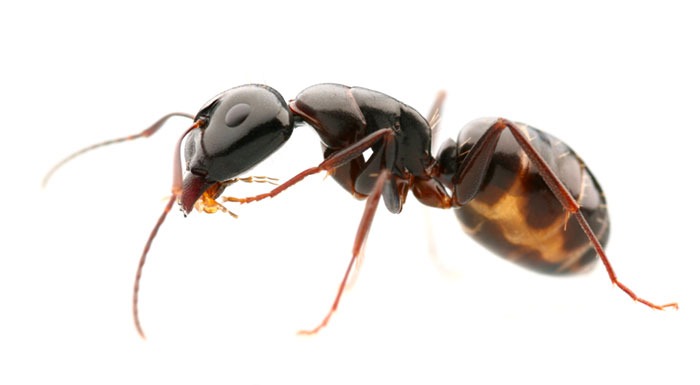
Ants are insects classified in the Formicidae family. They are related to wasp, bee and sawfly families, all of which belong to the Hymenoptera order. Insects in the Hymenoptera order are known for their qualities that are beneficial to the environment. Ants specifically help control populations of harmful insects like termites and pests that are harmful to agriculture.
There are over 15,000 known species of ants and they can be found nearly all over the world. The only areas on planet Earth that do not have ant populations are Antarctica, Greenland, Iceland, the Hawaiian islands, and some smaller Pacific islands. Australia is home to over 4,000 species of ants, the most of anywhere else in the world. The United States is home to 1,000 species of ants.
Identification
Ants are the only insects classified to the Formicidae family due to their unique appearance.
- Elbowed antennae
- Thorax – where the legs attached
- Some species also have stingers and poison glands for defense and hunting of prey
- Abdomen – where the internal organs are situated and includes:
- Stomach – digestion of food for the ant
- Crop – storage of food for the colony or the ant itself
- Reproductive organs
Traits
Ants are eusocial, meaning they organize themselves into highly-advanced colonies consisting of three ant castes: queens, workers and males (also known as drones).
The Queen
Once fertilized, the queen continues to produce eggs from the initial mating. A colony can have one or several queens, depending on the species of ant.
Males or Drones
The job of the drones is to mate with the queen (or future queens) after which they soon die.
Workers
The workers mainly stay in the nest caring for the queen and ant offspring. Most ant colonies create their nests in the soil, with some opting to base in areas where there is decomposing vegetation.
Diet
Ants are omnivores and eat meats, plants, seeds and fungus. They also get nutrients from aphid milk, other insects, nectar and sap, and dew.
Issues Ants can cause
Ants can cause harm by contaminating food they come into contact with. All ants can bite but most species in North America are generally not harmful to humans and pets.
Benefits of Ants
Ants are an essential part of the earth’s ecosystem. As they create the tunnels of their nests they are aerating and turning the soil. This allows plant roots to gain access to water and oxygen. Taking seeds into their nests for food also results in new plant growth.
Types of Ants in the Tri-state Region
The types of ants most commonly found in Pennsylvania, southern New Jersey and Delaware are Pavement ants, Odorous House ants and Carpenter ants.

Pavement ants
(Tetramorium Caespitum)
Pavement ants are black or brown and are usually 1/10 to 1/15 of an inch long. They are omnivores who eat a wide variety of foods but prefer sweets. They do not bite but they can sting. They originated from Europe and can be found across the United States. They are the most common type of ant found in Pennsylvania and most likely to be found in home infestations.

Oderous ants
(Tapinoma sessile)
Odorous House ants are black or brown and are monomorphic, meaning each ant in a colony is the exact same size. They are approximately 1/18 of an inch long and they do not bite. Their main threat to humans and pets is contamination. They are native to North America and can be found in Canada, the United States and Mexico.

Carpenter ants
(Camponotus pennsylvanicus)
Carpenter ants are reddish brown and range in size from ¼ to ½ inch. Their name derives from the way they create their nests, tunneling through wet wood. They will bite to defend their nests. This specific species was the first of its kind found in North America.
Behavior
Ants are social insects and live in colonies. They will use their pheromones to teach other ants. They don’t have ears, instead detecting sound by feeling vibrations through their feet. When ants perceive a threat, they will attempt to overtake it by swarming and biting.
Habitat
Most species of ant live in nests, organized by their colonies. These nests can be underground, located under rocks, sidewalks or structures. Some nests are built above ground using sand, gravel, even small twigs. Carpenter ants will live in old logs or trees anywhere there is a nearby source of moisture.
Lifecycle
Ants go through four stages of metamorphosis – egg, larva, pupa and adult – with the process generally taking 34 to 83 days. The lifespan of ants ranges from two months to ten years, depending on the species and their role in the colony.
Colony Structure
An ant colony can have between 3,000 to 500,000 ants, depending on the species. Each ant has a specific role according to their function within the colony: queen, soldier, worker or drone. An ant colony can have more than one queen, depending on the species. These roles will change as the ant ages, with each job moving them further from the queen.
Learn more about ant colonies.
Feeding
Ants favor sweets and will eat any sugary food like pastries, fruit juices, honey, sugar, syrups and other sweets. They are also known to eat dairy products, meats and cooked and raw vegetables, dead insects and other proteins. Carpenter ants do not eat wood. They remove wood by creating tunnels for their nests.





